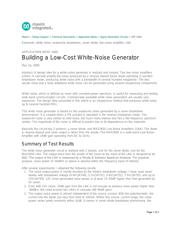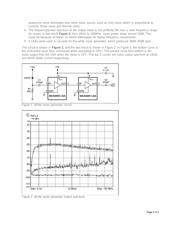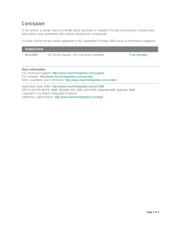下载

Maxim > Design Support > Technical Documents > Application Notes > Signal Generation Circuits > APP 3469
Keywords: white noise, avalanche breakdown, zener diode, low-noise amplifier, LNA
APPLICATION NOTE 3469
Building a Low-Cost White-Noise Generator
Mar 14, 2005
Abstract: A design idea for a white-noise generator is realized and revised. Two low-noise amplifiers
(LNAs) in cascade amplify the noise produced by a reverse-biased Zener diode operating in junction-
breakdown mode, producing white noise with a bandwidth of several hundred megahertz. The test
results show that a fairly wideband white noise can be generated using several inexpensive components.
White noise, which is defined as noise with constant power spectrum, is useful for measuring and testing
wide-band communication circuits. Commercially available white noise generators are usually very
expensive. The design idea presented in this article is an inexpensive method that produces white noise
up to several hundred MHz.
This white noise generator is based on the avalanche noise generated by a zener breakdown
phenomenon. It is created when a PN junction is operated in the reverse breakdown mode. The
avalanche noise is very similar to shot noise, but much more intense and has a flat frequency spectrum
(white). The magnitude of the noise is difficult to predict due to its dependence on the materials.
Basically the circuit has 2 portions: a zener diode, and MAX2650 Low Noise Amplifiers (LNA). The diode
is reverse-biased and noise output is taken from the anode. The MAX2650 is a wide-band Low-Noise-
Amplifier with 19dB gain operating from DC to 1GHz.
Summary of Test Results
The white noise generator circuit is realized with 2 boards, one for the zener diode, one for the
MAX2650 LNA. The output trace from the anode of the zener to the input of the LNA is designed to be
50Ω. The output of the LNA is measured by a Rhode & Schwarz Spectrum Analyzer. For practical
purpose, noise power of -60dBm or above is desired within the frequency band of interest.
After several experiments, I obtained the following results:
1. The noise output power is mostly decided by the diode's breakdown voltage. I have used zener
diodes with breakdown voltage of 4V(1N749), 5.1V(1N751), 5.6V(1N752), 7.5V(1N755), and up to
12V(1N759). 12V zener generated noise power is at least 15~20dB higher than that generated by
5V zener.
2. Even with 12V zener, 20dB gain from the LNA is not enough to produce noise power higher than
-60dBm. We need at least two LNAs in cascade (38~40dB gain).
3. The output noise power is almost independent of the source current. With the potentiometer, the
current into the diode can vary from 0mA to 100mA. Within this source current range, the noise
power varies pretty randomly within ±1dB. It seems in zener diode breakdown phenomena, the
Page 1 of 3





